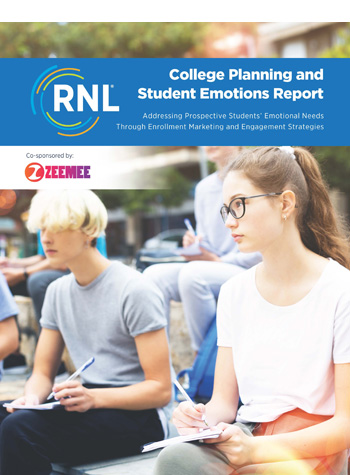enrollment
Helping Students Navigate the College Application Maze

The college application process is a pivotal and often overwhelming experience for high school students. As they strive to shape their academic futures, the journey can be both exciting and daunting. Recognizing the challenges that prospective students face, colleges have a unique opportunity to support and guide applicants through the application experience.
RNL and ZeeMee are conducting ongoing research with thousands of 12th graders and on this blog, I will share what the students are telling us about the process. Based on that, we will explore the several ways in which colleges can assist prospective students in successfully completing their college applications. (You can also read our first report on college planning and student emotions.)
The top roadblocks to the college application process
We have so far asked nearly 2,500 12th graders: “What is making it difficult for you to finish your college applications?” The top responses:
- Knowing the exact cost and figuring out how to pay for it.
- Filling out the FAFSA.
- Finding the right fit (finding the right school).
- Not knowing where to start.
6 application completion strategies
Given these findings, what can colleges do to help students complete their applications? Here are some of our favorite application completion assistance strategies.
1. Transparent application processes
Colleges can start by ensuring that their application processes are clear and transparent. This includes providing detailed instructions, checklists, and timelines on their websites. A user-friendly online application portal with easy navigation can significantly reduce confusion and help applicants understand the necessary steps. A student should not have to wonder, stress, and worry about their admission if the admission requirements are easy to understand.
2. Accessible resources
Many high school students do not have access to resources such as college counselors or test prep services. Colleges can bridge this gap by offering accessible resources online or on-campus. This may include webinars, workshops, and informational materials that provide insights into the application process, essay writing tips, and guidance on standardized tests. This may be particularly helpful for first-generation students and their families.
3. Financial aid information
The cost of education is a major concern for all prospective students. Colleges can play a crucial role by offering comprehensive information about financial aid options, scholarships, and grants. Clear and concise information about application deadlines, eligibility criteria, and the application process for financial aid can help students plan and navigate their way through this critical aspect of college applications.
Offering guidance and counseling while the students are applying, answering questions fast, and directing students to helpful resources will be key for all students, but especially for first-generation students who have less support and guidance at home, and at school.
Read College Planning and Student Emotions
Find out what 10,000 high school students told us about how stress and anxiety impact the college search process. The College Planning and Student Emotions Report provides fresh insights into how we communicate college-bound high school students during the college planning and enrollment process.
4. Application assistance events
Hosting application assistance events in person or online can be immensely beneficial. These events can provide hands-on support for completing applications, understanding requirements, and troubleshooting any issues in real-time, including financial aid forms, scholarship applications, and FAFSA filing.
5. Community outreach and partnerships
Collaborating with community organizations, high schools, and local nonprofits can amplify the impact of colleges in reaching low-income students. By participating in community outreach events, colleges can share information, provide resources, and establish a supportive network that extends beyond campus boundaries.
Partnerships and frequent communication with high school counselors is a key to supporting all students, but specifically first-generation students who will rely on counselors a bit more heavily than those whose families or parents are college educated.
6. Technology accessibility initiatives
Ensuring that low-income students have access to necessary technology is crucial in today’s digital age. Colleges can implement initiatives that provide laptops, internet access, and software resources to students who may otherwise face technological barriers. This ensures that every student has an equal opportunity to engage in the online components of the application process.
Invite students to be part of an online community where they can meet and bond with other prospective students interested or applying to the same college.
When students with similar interests come together, the growth possibilities become limitless. Group discussions and shared resources can enhance the process’s understanding and encourage students to take the next steps. This is why we include student communities in RNL Student Search to Enrollment.
Get to know the inquiries in your funnel
With limited time and resources and large inquiry pools, it can be challenging to meaningfully engage all students in your inquiry pool to generate and complete applications. Even when following all the best practices listed above, some students will never submit and complete an application. That is okay! But your data can help show you this. We suggest investing in strong predicative enrollment models and survey data that help paint a clear picture of which students are the most likely to apply and enroll. This will allow you to invest your time and energy in engaging with the students where you can have the largest impact.
The college application process is key for prospective students, and colleges have a unique opportunity to guide and support them on this journey. By implementing transparent processes, offering accessible resources, and providing personalized guidance, colleges can help make the application experience more inclusive and less stressful. In doing so, they contribute to creating a pathway for a diverse range of students to access and succeed in higher education.
Talk with us about how you can make the application process smoother for students
How can you help more inquiries move to applying—especially those who are a great fit for your institution? That’s something we help hundreds of colleges with each year. Find out how we can help you. Reach out and set up a time to talk to our enrollment experts.

